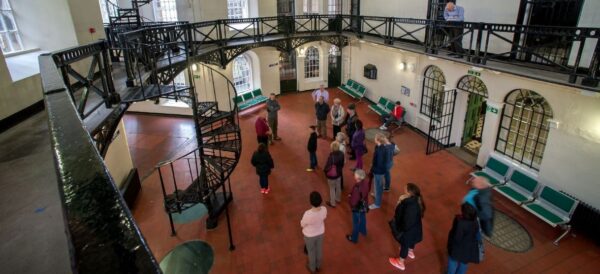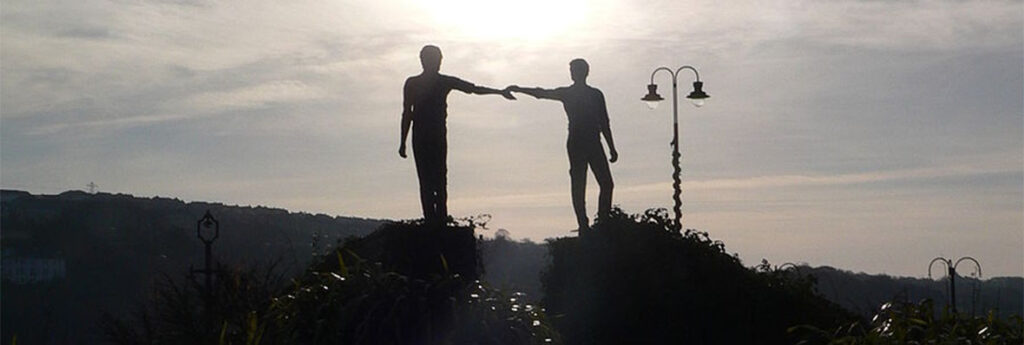This week marks the 25th anniversary of the Good Friday Agreement (April 10, 1998), which ended the ‘Troubles’ in Northern Ireland. With this in mind, Tourism Ireland has produced a top 10 list designed to help visitors delve into the region’s fascinating if tumultuous history while at the same time discovering its regenerated present.
Across Northern Ireland there are reminders of its troubled past – captured on street walls, in museum exhibitions and in visitor attractions. Through them, visitors can delve into Northern Ireland’s story and begin to understand the complex history that manifested itself during a destructive 30-year period from 1968 to ’98 that pitted protestant unionists who wanted to stay part of the United Kingdom and Catholic separatists who want to join Ireland.
Here is the tourist board’s curated top 10 list, mixing past and present, and which is guaranteed to demonstrate how much things have changed in just 25 years:
1. Take a Black Taxi Tour
One of the best ways to see and learn about the history of Belfast is on a Black Taxi Tour. These tours are guided by people who lived through the Troubles and offer a unique insight into the city’s past. The tour stops at Belfast’s famous political murals that portray loyalty and faith, solidarity, revolution, but also violence, death, and grief. It also visits the city’s most prominent Peace Walls.
2. The Troubles and Beyond exhibition
Belfast’s award-winning museum is located in the beautiful Botanic Gardens and has a permanent exhibition that tells the history of Northern Ireland from the late 1960s to the present day. It covers not only Northern Ireland ’s political history but also its social, cultural, and economic history.
3. Museum Deep Dive
For those who want a deeper dive, the Linen Hall Library has a unique collection of over 350,000 items relating to the Northern Ireland Troubles. The historic city centre building dates to 1788 and has links to the United Irishmen movement of the 18th century.
4. Tour Parliament Buildings
The seat of Northern Ireland’s devolved Assembly is an imposing building made of white Portland Stone set atop a hill. Free tours of the building describe the details of its grand architecture and take visitors into the ornate Great Hall and the two chambers – the Senate and the Assembly. The tour also reveals intriguing details about the political history that has unfolded in the building.
5. Visit Crumlin Road Gaol

Crumlin Road GaolBelfast’s evocative prison (photo) has a history that stretches back to 1845. It was in use until 1996 but is now a top visitor attraction. A guided tour will take visitors through 150 years of history, exploring the building’s enthralling past and gaining a unique insight into the daily lives of prisoners and prison officers. A separate wing of the building is currently being developed into a whiskey distillery and visitor experience.
6. Discover Hillsborough Castle & Gardens
Hillsborough Castle is Northern Ireland’s royal residence and has been the location for countless political meetings. To mark the anniversary of the Good Friday Agreement, special Politics Tours of the building (21–23 April) will explore its role in the peace negotiations. Drawing on recent interviews conducted with politicians, diplomats and those who were present at the talks, the tours will give an insight into what went on behind the scenes.
7. Relax in the Europa Hotel
Once famous as the world’s most bombed hotel, the Europa now stands as a symbol of peace and renaissance in Belfast. With its elegant piano lounge and fine dining, the four-star, city-centre hotel is popular with locals and visitors alike. It has welcomed many world-famous names, including US president Bill Clinton, who stayed there in 1995 when he took part in the peace talks. A great place for an indulgent afternoon tea or cocktail.
8. Explore the Museum of Free Derry
Telling the story of what happened in Derry-Londonderry from 1968 to 1972 (the Free Derry period) through the eyes of the community, the Museum of Free Derry features key events in Northern Ireland’s history. These include the civil rights marches, the Battle of the Bogside, internment, Bloody Sunday, and a notorious British Army operation called Operation Motorman.
Close to the museum is the famous wall announcing, “You are now entering Free Derry” – now a popular place to grab a selfie.
9. Get to know Derry-Londonderry’s famous sons and daughters
Visit the city’s historic Guildhall Building to see the Nobel Peace Prize that Derry man John Hume won for his role in Northern Ireland’s peace process. It’s on display alongside his other awards – the Martin Luther King Jr. Non-Violent Prize and the Mahatma Gandhi Peace Prize.
Derry-Londonderry’s most famous daughters are probably the Derry Girls (including the “wee English fella”). The TV sitcom phenomenon was a window into life in the city in the years running up to the Good Friday Agreement. A new exhibition about the program is planned for the Tower Museum, together with a new Derry Girls Trail, which will include a visit to the must-see mural.
10. Cross the Peace Bridge
Walk or cycle across the Peace Bridge, an elegant piece of architecture that joins Ebrington Square with the rest of Derry-Londonderry’s centre. The bridge is designed with two identical halves, each suspended from a single, inclined steel pylon, which overlaps at the centre of the river to form a ‘structural handshake.’ The design is a metaphor for reconciliation and hope and draws on the sculpture “Hands Across the Divide” by Maurice Harron which is nearby.

